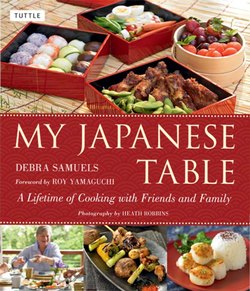Читать книгу My Japanese Table - Debra Samuels - Страница 12
На сайте Литреса книга снята с продажи.
ОглавлениеChapter One
Sushi
Today, sushi is everywhere. Like bagels, pasta, and espresso before it, sushi has been embraced around the world. I bought sushi takeout at the supermarket down the block from our son’s apartment in Berlin, in a market in Nova Scotia, and at a kosher restaurant in Brooklyn, New York (all for research purposes of course)! But when I saw a shelf filled with sushi rolling mats (maki-su), short grained sushi rice, wasabi, and ginger at a neighborhood grocery in Tel Aviv, Israel, I realized that folks not only buy sushi, they make it as well.
Sushi is not raw fish. That’s sashimi. Sushi is the combination of vinegared rice and what you put on, around and inside of it—including vegetables, eggs and even a piece of rare beef—determines the type of sushi. For the most part, handling raw fish should be left to professionals. Proper storage temperatures, knife and cutting board hygiene are critical for a safe eating experience. Always purchase fish for sushi at a trusted source. Much of the raw fish in our markets is caught and frozen right on the fishing vessels. This “super freezing” process is done quickly and at the appropriate temperatures, and “sushi or sashimi grade” refers to fish that has been handled in this manner. Freezing kills parasites, so in this case “previously frozen” is a good thing.
What we now call “sushi” started out as a way to preserve fresh fish. At one time, raw fish was set between layers of rice for preservation and would begin to ferment, and the rice was discarded before the fish was consumed. Like many happy accidents, this turned the rice into something special and a new cuisine was born. One dish that did evolve directly from that layering of rice and fish is pressed sushi (oshi-zushi), which is then cut into rectangles. Try my version with Smoked Salmon Pressed Sushi using Spicy Mayonnaise, and shiso leaves (p. 53). It's great for when you have a sushi-loving crowd to feed.
This chapter will introduce you to homestyle sushi. Part of almost every home cook’s culinary skill set is to be able to make a thick roll of sushi rice stuffed with vegetables and seafood (futo-maki), wrapped in roasted seaweed. Try your hand at the Classic Sushi Roll (p. 40). I leave nigiri-zushi, the little rice pillows with a smear of wasabi and raw fish set on top, to trained professionals.
Good sushi means learning the proper way to make and season sushi rice (p. 38). Short and medium grain rice both are suitable and are a matter of personal preference. I tend to use short grain rice, as I like the feel of the smaller grain in my mouth. The rice is dressed in a sweet and sour mixture of rice vinegar, sugar, and salt (sushi-zu). The sweetness of the rice varies by region in Japan, with the Osaka-style being sweeter than its Tokyo competitor. Since much of my time has been spent in Tokyo, you may want to slide that sugar scale upward.
Sushi made with brown rice (genmai) may be heretical to many, but it has been embraced outside of Japan, even by some Japanese. I have come around to seeing it as a welcome innovation (p. 39). Make a roll (maki) or use it in hand rolls for A Sushi Hand Roll Party (p. 46) for a home-style sushi feast.
How to Make Sushi Rice
